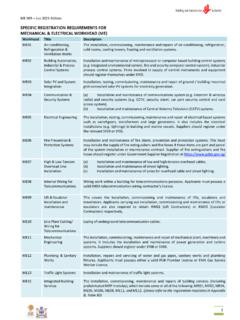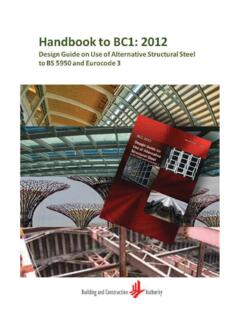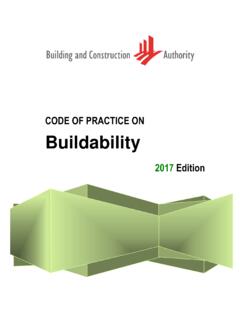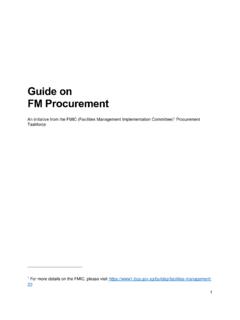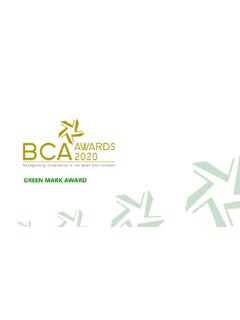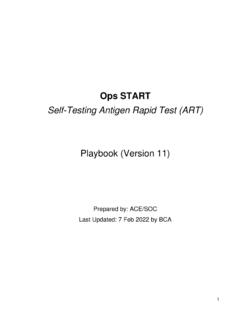Transcription of SUSTAINABLE CONSTRUCTION - Building and Construction …
1 Printed on recycled PaperA Guide on the Use of recycled MaterialsBCA SUSTAINABLE CONSTRUCTION Series - 4 SUSTAINABLE CONSTRUCTIONSUSTAINABLE CONSTRUCTION | A Guide on the Use of recycled MaterialsA Guide on the Use of recycled MaterialsSUSTAINABLE CONSTRUCTIONC opyright @ 2008 Building and CONSTRUCTION Authority, rights reserved. This document or any part thereof may not be reproduced for any reason whatsoever in any form or means whatsoever and howsoever without the prior written consent and approval of the Building and CONSTRUCTION every effort has been made to ensure the accuracy of the information contained in this publication, the Building and CONSTRUCTION Authority, its employees or agents shall not be responsible for any mistake or inaccuracy that may be contained herein and all such liability and responsibility are expressly disclaimed by these said 978-981-08-0737-5 SUSTAINABLE CONSTRUCTION | A Guide on the Use of recycled Materials1 FOREWORD Scarcity of land and other resources is a reality, particularly in a small country like Singapore.
2 It is therefore critical for us to make the best use of limited resources, and at the same time be prepared to tackle any challenges that may arise in the SUSTAINABLE CONSTRUCTION , we can do our part to optimise the use of natural resources and pursue the greater use of recycled materials. Besides reducing our dependence on natural Building materials, this will also help to safeguard our quality of life and make provision for the continuing growth of our built Building and CONSTRUCTION Authority (BCA) has been working closely with industry partners to promote wider adoption of SUSTAINABLE materials in our built environment. The completion of SS EN 12620: Specification for Aggregates for Concrete, has paved the way for the use of alternative substitutes to natural aggregates, and it is timely for industry professionals to adopt this new Singapore Standard in the design and CONSTRUCTION of publication provides useful information on recycled materials and technical considerations for their applications.
3 I urge all stakeholders in the industry to make a concerted effort to adopt the use of recycled materials in their Building projects. I believe that with the greater use of recycled materials, the industry will reach another significant milestone in contributing to a SUSTAINABLE built John KeungChief Executive OfficerBuilding and CONSTRUCTION Authority SUSTAINABLE CONSTRUCTION | A Guide on the Use of recycled Materials2 DEFINITION OF TERMS 4 SS EN 12620: SPECIFICATION FOR 5 AGGREGATES FOR CONCRETEB ackground 6 New Requirements 7 New Test Methods 8 TYPES OF MATERIALS 9 Washed Copper Slag 10 Steel Slag 16 CONSTRUCTION & Demolition waste 19 recycled Concrete Aggregates 22 Wood waste 27 Milled waste 30 Other Wastes 32- Incineration Bottom Ash 32- Excavated/ Dredged Materials 34 ACCREDITATION SCHEME FOR 39 recycled aggregate SUPPLIERS Background 40 Accreditation Criteria 41 Enquiry 42 CONTENTS593943 SUSTAINABLE CONSTRUCTION | A Guide on the Use of recycled Materials3 APPLICATIONS OF recycled
4 MATERIALS 43 Eco-concrete 44 Products Using recycled Materials 48 Roads & Pavements 50 Backfilling and Soil Stabilisation 53 GREEN MARK RELATED INFORMATION 55 Point Allocations 56 LIST OF RECYCLING PLANTS 59 SUPPLIERS 63 Eco-Concrete Ready Mix Concrete Suppliers 64 Precast & Other Product Suppliers 66 REFERENCES 69 RELEVANT SPECIFICATIONS/CODES 71 Summary of Changes 72 International Specifications/ Codes 73 Singapore Specifications/ Codes 74 ACKNOWLEDGEMENTS 75 PHOTOGRAPHS/GRAPHICS CREDIT 7755596369 SUSTAINABLE CONSTRUCTION | A Guide on the Use of recycled Materials4 DEFINITION OF TERMSThe following terms and definitions are used in this guidebook: Eco-concrete Eco-concrete is defined as concrete with at least 50% by mass of total aggregate content replaced by recycled materials, used for non-structural applications.
5 Typical materials used for aggregate replacement include washed copper slag or recycled aggregates or a combination of both recycled aggregate (RA) aggregate resulting from the processing of inorganic material previously used in CONSTRUCTION recycled Concrete aggregate (RCA) recycled aggregate comprising principally of crushed concrete Manufactured aggregate aggregate of mineral origin resulting from an industrial process involving thermal or other modification Structural Works Works in relation to those parts or elements of a Building which resist forces and moments and includes foundations, beams, columns, shear cores, slabs, roof trusses, staircases, load-bearing walls and all other elements designed to resist forces and moments SS EN 12620: SPECIFICATION FOR AGGREGATES FOR CONCRETESUSTAINABLE CONSTRUCTION | A Guide on the Use of recycled Materials5SS EN 12620.
6 SPECIFICATION FOR AGGREGATES FOR CONCRETESUSTAINABLE CONSTRUCTION | A Guide on the Use of recycled Materials6SS EN 12620: SPECIFICATION FOR AGGREGATES FOR CONCRETEThe quality and grading requirements of natural aggregates for concrete are currently specified by Singapore Standard SS 31: Specification for Aggregates from Natural Sources for Concrete. SS 31 is generally based on the British Standard and pertains to aggregates obtained by mechanical processing of natural United Kingdom s adoption of the European Standard (EN), the British Standard (BS) will eventually be withdrawn and its publications discontinued. With this in mind, Singapore has decided to follow suit with the adoption of EN standards.
7 Hence, BCA initiated a working committee under the auspices of SPRING Singapore to review BS EN 12620: Aggregates for Concrete, on its suitability (and make modification, if necessary) for use in Singapore. The committee has concluded its work with the publication of SS EN 12620: Specification for Aggregates for new SS EN 12620 will eventually replace SS 31. It is similar to the BS EN 12620 but has additional guidelines on an alternative testing scheme for factory production control of natural aggregates that are imported into Singapore from sources without a system of product quality control. BackgroundSUSTAINABLE CONSTRUCTION | A Guide on the Use of recycled Materials7SS EN 12620: SPECIFICATION FOR AGGREGATES FOR CONCRETESS EN 12620 covers a wide range of aggregates ( as compared with SS 31 which specifies aggregates from natural sources only).
8 It permits the use of aggregates (including filler aggregates for concrete) from natural and manufactured sources, including recycled materials and mixtures of these aggregates. Unlike SS 31 which prescribes quality and grading requirement of aggregates, the specification of aggregates under SS EN 12620 is based mainly on performance with limiting values on certain aggregate natural aggregates, there is a requirement for producers of aggregates to have a system of factory production control to monitor conformity of the aggregates with the relevant requirements of the standard. However in the case of Singapore where aggregates are imported from sources without a system of product quality control, SS EN 12620 requires importers of aggregates to undertake an alternative testing scheme in lieu of factory production control.
9 It is recommended that SS EN 12620 be read in conjunction with PD 6682-1: Guidance on the Use of BS EN 12620 as this UK guidance provides recommendations on limiting values for aggregate properties within the ranges permitted in SS EN 12620. The recommended values given in PD 6682-1 are also specified in SS 31 and BS 1047: Air-Cooled Blastfurnace Slag aggregate for Use in CONSTRUCTION . Further guidance on limiting values for aggregate properties can also be found in BS 8500: Concrete - Complementary British Standard to BS EN 206-1, particularly for the use of recycled aggregates in concrete. BS 8500 contains requirements for both the use and testing of recycled concrete aggregates and recycled aggregates.
10 New RequirementsSUSTAINABLE CONSTRUCTION | A Guide on the Use of recycled Materials8 New Test MethodsAnother key change resulting from the use of SS EN 12620 is that aggregates will be subjected to a new series of European test methods. This new series of test methods are more comprehensive than those referred in SS 31. However not all test methods will be routinely specified for use in Singapore as some of these tests are only required when needed to meet user s requirements in specific a better understanding of the European test methods, PD 6682-9: Guidance on the Use of European Test Methods Standards gives a description of each European test method standard along with guidance on their relevance and familiarity to users of test methods specified in British Standards.
